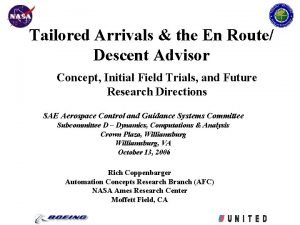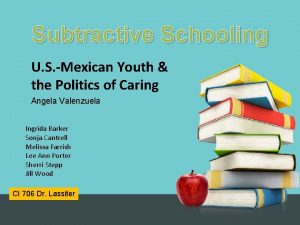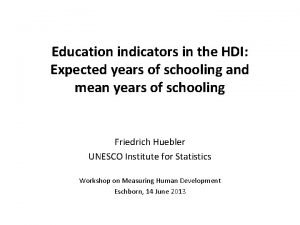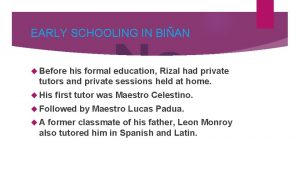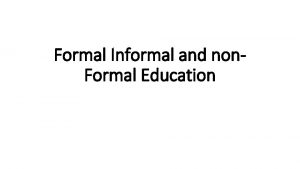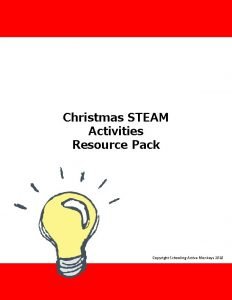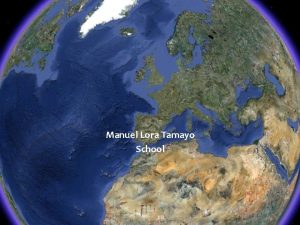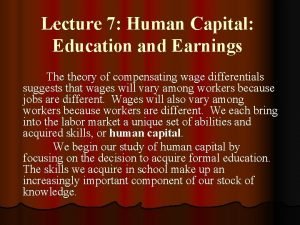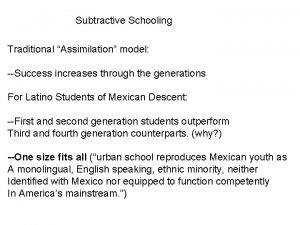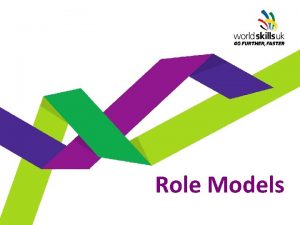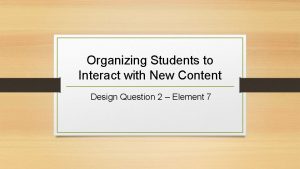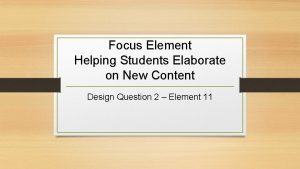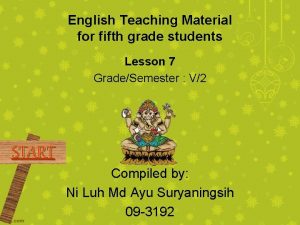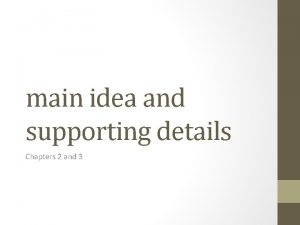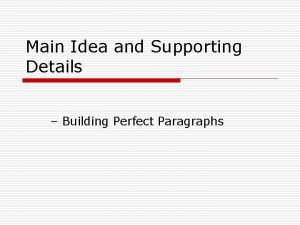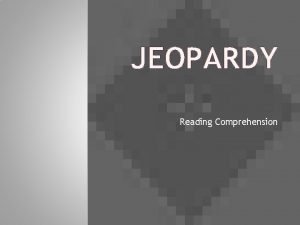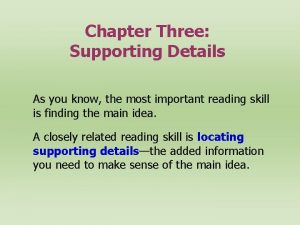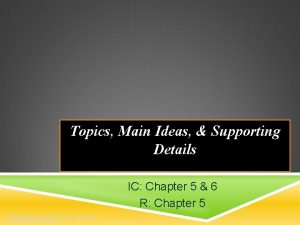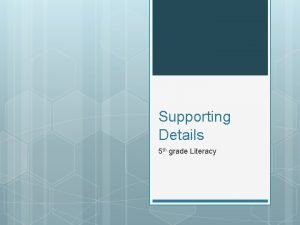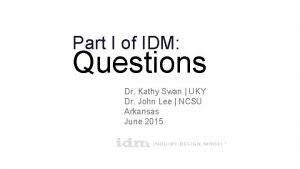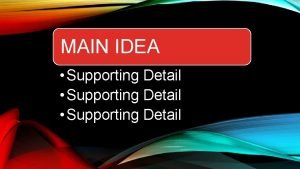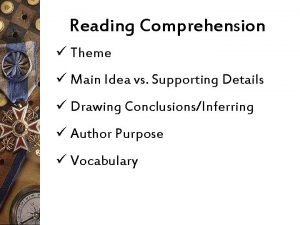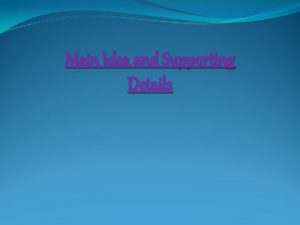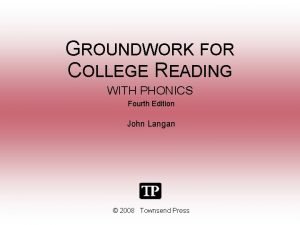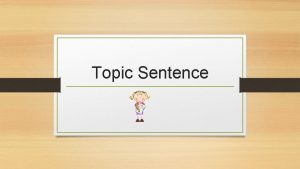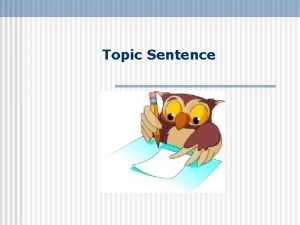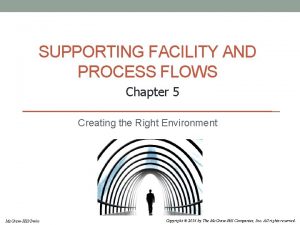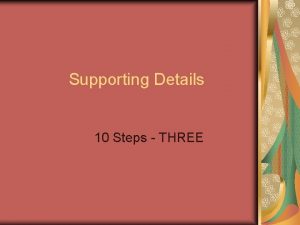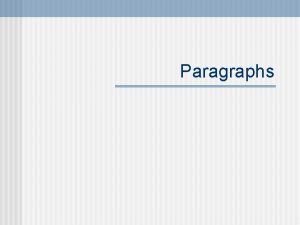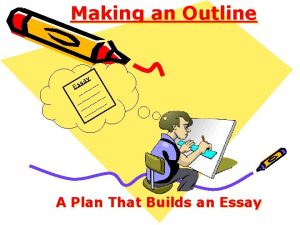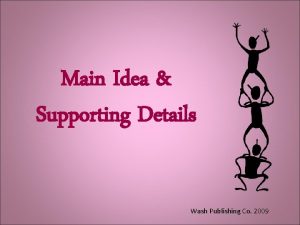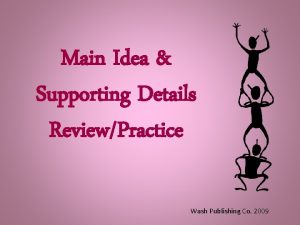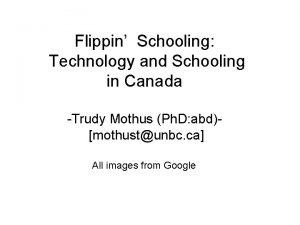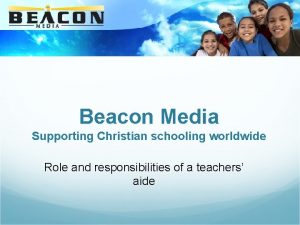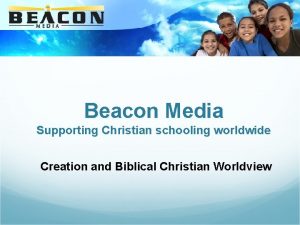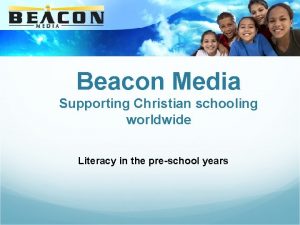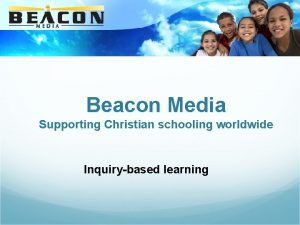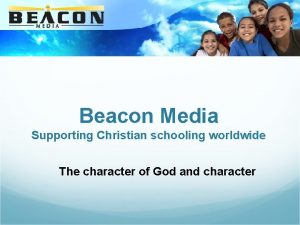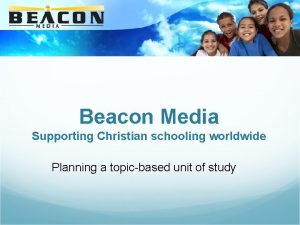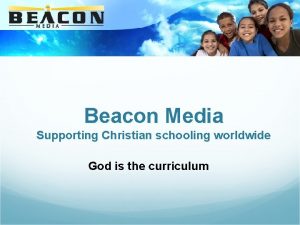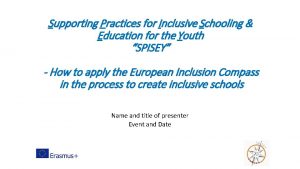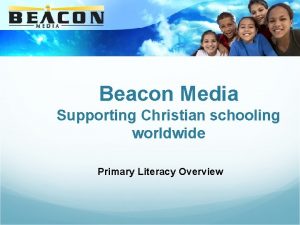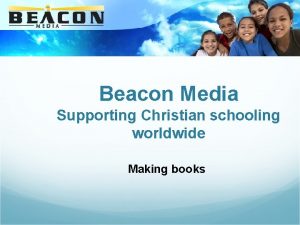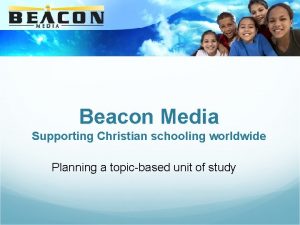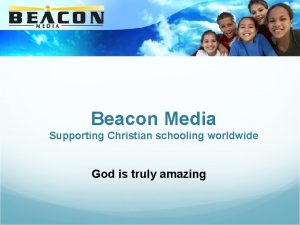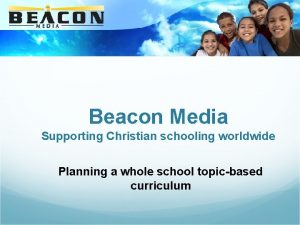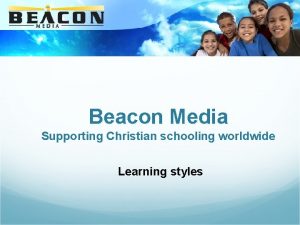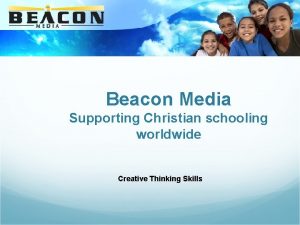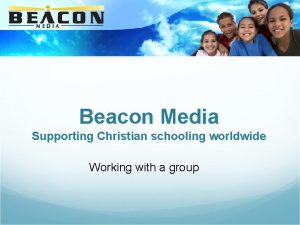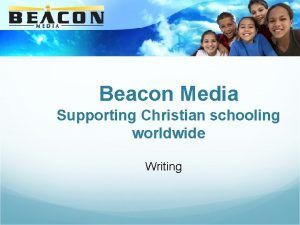Supporting new arrivals and new to schooling students

















































- Slides: 49

Supporting new arrivals and new to schooling students in mainstream lessons in secondary schools (A - low B in EAL Proficiency Scales) (EAL Steps 1 -3) GEORGINA VINCE EAL CO-ORDINATOR – CO-OP ACADEMY LEEDS

In this session, we will: discuss some of the challenges that teaching New to English & New to Schooling students can present to mainstream teachers in secondary schools and how to meet these students' needs. look at strategies to support these students and staff teaching these students and examples of resources that teachers have developed to differentiate for and support these students. give practical ideas that can be used in different situations.

“ What is your experience of working with EAL, New to English and New to Schooling students and working with them in mainstream lessons? Get into groups with people you don’t already know and share your experiences. ”

1. Who are we talking about? WHO ARE THESE STUDENTS?

What can/ can’t the students do? EAL Proficiency Levels New to English A May use first language for learning and other purposes. May remain completely silent in the classroom. May be copying/repeating some words or phrases. May understand some everyday expressions in English but may have minimal or no literacy in English. Needs a considerable amount of EAL support. Early acquisition B May follow day to day social communication in English and participate in learning activities with support. Beginning to use spoken English for social purposes. May understand simple instructions and can follow narrative/accounts with visual support. May have developed some skills in reading and writing. May have become familiar with some subject specific vocabulary. Still needs a significant amount of EAL support to access the curriculum.

What can/ can’t the students do? EAL Proficiency Level A – EAL Step 1 Surviving a session/ school day Speaking & Listening Ø Can understand say words and phrases associated with the classroom and with immediate needs, e. g. pencil, miss, toilet, drink. Reading & Writing Can read and write own name. Can recognise important signage around school, e. g. toilets, exit. Ø Can work out what is being said if it is about familiar, routine matters, e. g. Go to the library. Tidy up time. Can recognise labels in classrooms and on equipment. Ø Can say facts about routines, e. g. teacher not here, book home. Ø Can answer single step wh questions about routines and lesson content, in words or short phrases, e. g. Where is your coat? What is this? (On) Which day is swimming? Can recognise some common significant words by shape or by first letter. Can form most English letters and copy known words. Can conform to taught expectations about layout. Can use an age appropriate dual language dictionary. Ø Can communicate with people who structure communication carefully (e. g. by using objects, gesture and expressions appropriate for a beginner).

What can/ can’t the students do? EAL Proficiency Level A-B – EAL Step 2 Reacting to learning experience Speaking & Listening Ø Ø Can understand when others talk about familiar things, practical things and anything with plenty of contextual support, as long as they avoid long, complicated sentences, e. g. Find Henry VIII instead of Look through that list until you find Henry VIII (also called Henry Tudor). Can communicate content about concrete matters during familiar tasks, e. g. put water in beaker, you in goal today. Ø Can express the simplest parts of lesson content if it has been delivered with contextual support. May use or point to artefacts/images to convey their message. Ø Can communicate content in longer phrases and in sentences with scaffolding. Ø Can recognise that verbs change form, and uses elements of tenses but cannot yet use verb forms with accuracy. Reading & Writing Can respond to one-step wh questions relating to images and familiar text. Can read simple sentences relating to images which have already been discussed. Can locate important high content words in texts (e. g. names of characters). Can understand significance of full stops and capital letters in reading and in writing. With scaffolding, can construct short sentences using familiar content. Ready to attempt independent writing in some contexts. Can recognise most initial consonants to support decoding and spelling.

What can/ can’t the students do? EAL Proficiency Level B – EAL Step 3 Engaging more independently Speaking & Listening Ø Can use the support systems and scaffolding offered in class (e. g. audio files, glossaries, writing frames, vocabulary book). Ø Understands own needs in class, e. g. works towards objectives, asks for clarification in a focussed way, roughs out drafts, seeks information in own preferred language. Reading & Writing Can locate and use features such as title, blurb, contents, search, tabs. Can retrieve information from texts and dictionaries at a simple level. Can read with understanding a differentiated or specially written text. Ø Can recall and re-use important vocabulary taught in context; vocabulary is growing noticeably faster. Can use phonic skills to support decoding and spelling. Ø Can generalise how to construct a sentence, so independent speech now has more features such as plurals, positional language, adjectives and basic conjunctions. The pupil can express much more of lesson content and is less dependent on frequently heard phrases. Mistakes are still common, e. g. The book is about a boy who wear stripe pyjama. Can write sentences about familiar content (although spelling and syntax may be irregular). Can use models and scaffolds to support writing. Handwriting can be easily read. Can use question marks, exclamation marks and commas.

“ What would the needs and difficulties of New to English & New to Schooling students be in mainstream lessons? How would New to English and New to Schooling students compare? What could they bring to the lessons? Discuss in your groups. ”

What’s the difference? New to English Literate in own language Used to schooling system Prior knowledge of content Independent learning skills Just need to learn language New to Schooling Not literate in own/ any language Not used to systems Lack both content and language Lack other skills for learning

What particular difficulties might these students have in addition to not knowing the language? This is especially relevant to new to schooling students School routines: understanding how the school system works eg. attendance, rewards & behaviour systems etc. In the classroom: sitting still/ on a chair looking at the teacher when they are talking using scissors/ glue/ ruler/ rubber copying correctly understanding concept of time colouring (in the lines) understanding concept of having to be in a particular lesson at particular time tidying up after activity following a timetable packing bag at end of lesson reading a timetable telling the time (in any language) remembering things needed for school eg. planner/ pen/ PE kit Using computers: turning on computer remembering username/ password knowing the correct way to speak to someone saving document (in the right place) responding correctly to someone when spoken to finding document they’ve saved copying and pasting

What do I need to know about these students in my class? Different levels of English of different students in the class (EAL Proficiency Levels/ Steps or other assessment used) – there can be a wide range even within students at such a low level and therefore need for differentiation. What language(s) they speak. If they are literate in their first language. If they have prior education and to what level. How long they’ve been in England/ this school/ English schools.

“ What would you expect to see in a good mainstream lesson with New to English & New to Schooling students? What strategies might you use/ recommend? Discuss in your groups. ”

2. Planning lessons for these students FIRST STEPS - BASIC GUIDANCE & EXAMPLES

What do I do if I have students of this level in my class? This is some general guidance of what we would expect in classes where there are low level EAL students. We would expect to see: Lessons should: be accessible to students both in language & content. support students’ understanding of language, content and classroom routines. Students’ 1 st language. teach students key words. Simplified language. develop students’ language. Differentiation for language level. Clear classroom routines. More of a focus on language development alongside the subject content in comparison to other classes. Lots of visuals. Use of colour. Regular focus on key words. In the following slides, there is simple guidance on planning a lesson for a class like this with examples you can adapt. There are further strategies and examples of good practice in the next section.

Planning a lesson for low level EAL Students 1 st Steps Try to use the same layout & format for all lessons and Power. Points/ worksheets to make it easier for low level students to follow – you can use the following slides and adapt. Keep to same routines in lessons & use images/ colour to support this eg. always have date, title and starter on board as students come in to room – see next slide for images. Think about content & language that will be accessible for these students and simplify from scheme of work eg. no more than 8 -10 new key words. Use same images for these words throughout lesson and reinforce students’ learning of them with lesson activities. Differentiation & Resources There will need to be differentiation throughout the lesson so that the lowest level students can access the lesson and the higher level students are stretched. You may want to divide the class into groups to support with differentiation – see following slides with guidance on how to differentiate for their language need. The differentiation can be kept very simple with small adaptions to worksheets and generic resources adapted for different key words. Have some additional very simple activities for the lowest level students for when they cannot access the main content/ language of the lesson – see examples.

Discuss/ speaking activity Peerassessment Writing task Research Think about… Criteria met Listening task Selfassessme nt Individual work Reading task / reading time Compare (answers? ) Question time – Questions from the pupils (Q’s from the teacher) Pair work You can shout the answer out! Team work Silen t work On MWB DIRT time Homework

What does progress in language for these students look like? *recognise/ match/ Step 1* & Step 2 (A) students Step 3 (B) students Step 4+ (B-C) students copy/ write key words with correct sized letters & correct spelling understand key words (write/ translate/ images) and use in simple sentences with support write simple sentences about topic independently using key words and more complex sentences with support use more complex language, connectives and structures with support to explain ideas in paragraphs

Model Lesson Format Use this format/ guidance & adapt to plan your own lesson for a New to English class

The 5 minute EAL Student Support Plan Students Names & EAL needs Key Words / Language skills Model Phrases What should students say/write/read? How can they use their first language? Resources to support learning (pics, maps, diagrams, real objects) Activity to access learning (speaking/reading/listening/writing? ) Pete Sanderson 2015 @Lesson. Toolbox

10 February 2022 Title Images for key words for lesson. Starter – You can write in English or in your language or draw pictures:

10 February 2022 Title LO: SC: ü…

Groups Step 1 -2 students Step 3 students Step 4 students

Key Words: Image for key word 1 Image for key word 4 Image for key word 2 Image for key word 3 Image for key word 5 First, introduce key words orally. Get students to listen & repeat as class and individually. Check understanding & pronunciation. Say word & they say number and vice-versa. Orally - Give definition & they say word. Ask students to give definition. Extension - Ask why they think these words are important for topic. Then introduce written words & check again. (Remember – don’t use capital letters unless they should have capital letters or students will copy) 6

Key Words: Image for key word 1 Image for key word 4 Image for key word 2 Image for key word 3 Image for key word 5 6 write the key words here (Remember – don’t use capital letters unless they should have capital letters or students will copy) Bronze – Copy the words with picture/ translation. Silver – Copy the words with a definition. Gold – Copy the words and use in a sentence to show the meaning. Extension: Practise the words using spelling strategies from your planner. Challenge! Can you make a quiz to test other students on the meaning or spelling of these words?

Speaking & Listening Activities – Let’s Practice/ What can you remember? (Depending on time in lesson) Activities: § Bingo § § Students write down numbers of images on bingo card (can draw in book) Teacher/ Higher level student says words (can say first in sentence for higher students) & students cross off to get line § Splat § § 2 students stand with back to board. Teacher/ Higher student says word (or sentence for higher students) & first student to touch image gets points. § Noughts & Crosses § Students get square for their team by saying word/ sentence (depending on level) for image & win by getting line. § What’s missing? § Have 3 x 3 (or 4 x 4) grid containing numbered images of key words + some extras. Remove one of images & students have to say what is missing. § Cut up picture cards § While teacher is talking to class about topic/ watching video, lowest level students hold up card/ put in order on table when they hear key word (or can just write number of image to make it easier).

Reading Activities Images linked to text/ key words. Text to be read – simplified/ differentiated with sentences/ paragraphs next to appropriate images, if possible. • Make sure any text you are going to use with a class is accessible in terms of language and content. • If possible, simplify the text to make it more accessible to the lowest level students. • Before reading, use images, key words and titles to get students to predict what will be in text/ what they think it will be about/ other words they think will be in text. • If not possible to simplify, weakest students can highlight key words in text and match to images while other students are reading. • Activities: • Matching: • Match words/ sentences/ paragraphs to images • Sequencing: • Cut up text and sequence text/ images together, text matching to images, text with no images • Language focus (for higher level students): • • Highlight particular language in text eg. verbs/ connectives Remove particular language from text and students complete with words given or without.

How much can you remember? Write the key words in the right place on the picture: Images for key words. Image related to content of topic HELP! Look back at the words in your book to help you. CHALLENGE! Can you remember the spellings without looking? Can you add extra words/ information/ put the words into sentences?

Bronze: Writing Activities Try to have images to illustrate the different stages of what you expect students to write eg. parts of a story/ stages in an experiment – these should be same images used throughout lesson, where possible. . • Fill in missing letters in a word with the full word elsewhere on the page • Copy a word next to the word • Match a word to a picture • Write word next to a picture (word elsewhere on page to copy) You could get students to put the images in order and describe what happens orally first. • Fill gap in a sentence (word elsewhere on page to copy/ 1 st letter given/ image) Using these same images on a worksheet to support students of all levels should help them to structure their writing, write more and remind them of vocabulary. • Write word next to a picture • Fill gap in sentence Create one worksheet for the class & then differentiate the worksheet with appropriate support for the different students’ levels. • Simple sentence to put in order • Simple sentence starter Silver: • Give simple sentence as model There are some examples on next slides. • Sentence to put in order • Sentence starter Images linked to text/ key words. • Questions to respond to Support/ space to write next to each image. • Rewrite sentences from text from memory Gold: • Paragraph starters • Models of language structures/ grammar to include • Model paragraph • Key words/ ideas to include in each paragraph • Questions to respond to • Linking words to include in writing • Pictures for ideas/ planning sheet/ frame

Spelling practice: Look, say, cover, write, check Look Write Check Write Images & words to copy for lowest level students Activity Gap-fill sentences: ü With images/ 1 st letters of words in gaps for lowest level students ü With gaps and words below or no words for higher students Check

Images for key words 1. A______ 2. P________ 3. _________ 4. _________ 5. _________ 6. _________ DON’T FORGET TO INCUDE THESE KEY WORDS IN YOUR WRITING! • Questions as prompt • Sentence starter________________. Model sentences Change sentences to correct grammatical form.

Images for key words Remember to use ____: examples Try to use: examples of connectives 1. ________ 2. ________ 3. ___________ 4. __________ 5. ___________ 6. ___________ DON’T FORGET TO INCUDE THESE KEY WORDS IN YOUR WRITING! • Question as prompt (use lines to show expectations of length or give expectation) __________________________________________________ _________________________ Questions to prompt (with language structures underlined) CHALLENGE! Include… Explain…

Further simple activities for lowest level students (Step 1): Simple ideas for differentiated activities to develop key language of the lesson for these students (they should not be learning more than 8 -10 new words in a lesson) – they could be doing some of these while rest of lesson is inaccessible: • Pictures to name/ hold up when word is said • Pictures with words to read • Words and pictures to cut up and match/ play pairs/ snap etc. • Pictures and words to match • Words to write under pictures • Draw pictures for words • Wordsearch* with words to find/ pictures of words • Crossword with pictures for clues • Fill in the missing letters • Jumbled letters* • Circle the right word • Bingo game • Label picture • Make word with plastic letters (using word to copy/ without word) • Write words on mini-whiteboard • Record words in orange books – translate/ draw pictures/ use in sentence • Practise writing in handwriting books/ on mini-whiteboards/ handwriting sheets for key words* • Make poster • Fill gaps in sentences • Match sentences to pictures • Find words in text • Spelling practice strategies eg. Look, Say, Cover, Write, check/ word shapes* • Colour key words for very lowest level students* *These are links to some websites for making simple key word activities: http: //tools. atozteacherstuff. com/printableword-shapes-worksheets/ https: //www. handwritingworksheets. com/flash /dnealian/index. htm https: //quickworksheets. net/generators/wordscramble/form 1. php https: //quickworksheets. net/generators/words earch/form 3. php http: //www. hellokids. com/print-my-name

What have you learnt today? Images for key words HELP! Today I have learnt about… _____ happened because…. . write the key words here Bronze – What key words have you learnt today? Can you spell them? Can you use them in a sentence? Silver – What have you learnt about ____? Use the key words in your answer. Gold – Can you explain why/ how _______ happened? Use key words in your answer. Challenge! Can you think of some questions you’d like to ask about this topic? What else would you like to know?

Example Lesson

The 5 minute EAL Student Support Plan Students Names & EAL needs All students EAL 18 NTE 3 B/C See groups slide Key Words / Language skills Portuguese America slaves sailors sugar ship Model Phrases What should students say/write/read? How can they use their first language? They took _____ from ____ to ______. Discuss ideas. Translate key words dictionaries Resources to support learning (pics, maps, diagrams, real objects) images of key words, map of North Atlantic, lay out classroom as triangle to act out trade Activity to access learning (speaking/reading/listening/writing? ) Listening activity & Splat with key words Activity to access learning (speaking/reading/listening/writing? ) Reading differentiated text about trade, oral questions and act out using classroom as model to show understanding Activity to access learning (speaking/reading/listening/writing? ) Practising key words in pairs using map. writing sentences/ paragraph about trade using differentiated support Pete Sanderson 2015 @Lesson. Toolbox

10 February 2022 The Slave Trade Starter:

10 February 2022 The Slave Trade LO: SC: ü…

Groups Yusufu Camara Dembo Jawara Sara Demeterova Nyara Sandeh Biancuta Avadenei Traian Grigoras Vasile Stoica Salwa Abdelrahim Alenia Gbessou Jakub Kaczerski Lorena Neculai Rita Takyiwah Jennifer Cervenakova Fatoumata So Marwa Alezzo Badr Alanaizi Filip Dumitru Vanessa Bandyova Sammy Mihai Zelin Wu Malaika Kouser

Key Words: 2 1 4 America 3 6 5 Portuguese ship triangular sailor sugar Bronze – Copy the words with picture/ translation. Silver – Copy the words with a definition. Gold – Copy the words and use in a sentence to show the meaning. Extension: Practise the words using spelling strategies from your planner. Challenge! Can you make a quiz to test other students on the meaning or spelling of these words?

The triangular trade Undifferentiated text – key words coloured The slave trade began with Portuguese, and some Spanish, traders taking African slaves to the American colonies they had conquered in the 15 th century. British sailors became involved in the trade in the 16 th century, and the Treaty of Utrecht (1713) gave them the right to sell slaves in the Spanish Empire. In the 18 th century, perhaps 6 million Africans were taken to the Americas as slaves, at least a third of them in British ships. For the British slave traders it was a three-legged journey, called the 'triangular trade': § § § Taking trade goods, such as guns and brandy, to Africa to exchange for slaves. Then taking the slaves on the 'Middle Passage' across the Atlantic to sell in the West Indies and North America. Finally, taking a cargo of rum and sugar back to sell in England. Conditions on the Middle Passage were terrible, and many slaves died.

The triangular trade The slave trade began with Portuguese, and some Spanish, traders taking African slaves to the American colonies they had conquered in the 15 th century. British sailors became involved in the trade in the 16 th century, and the Treaty of Utrecht (1713) gave them the right to sell slaves in the Spanish Empire. In the 18 th century, perhaps 6 million Africans were taken to the Americas as slaves, at least a third of them in British ships. For the British slave traders it was a three-legged journey, called the 'triangular trade': § § § Taking trade goods, such as guns and brandy, to Africa to exchange for slaves. Then taking the slaves on the 'Middle Passage' across the Atlantic to sell in the West Indies and North America. Finally, taking a cargo of rum and sugar back to sell in England. Conditions on the Middle Passage were terrible, and many slaves died.

The triangular trade The slave trade began with Portuguese traders. They took African slaves to America. British sailors started the trade in the 16 th century. In the 18 th century, they took 6 million Africans slaves to America. At least 1/3 were in British ships. The British called it the 'triangular trade’: § They took guns and brandy to Africa to exchange for slaves. § They took the slaves across the Atlantic to sell in America. § Finally, they took rum and sugar back to sell in England. Conditions on the ships were terrible. Many slaves died.

The triangular trade The Portuguese first took slaves from Africa to America. In the 1500 s, British sailors first took slaves. In the 1700 s, they took 6 million African slaves to America. It was like a 'triangle’: § They took guns to Africa. § They took slaves from Africa to America. § They took rum and sugar from America to England. The ships were terrible. Many slaves died.

The triangular trade – How much can you remember? Put the key words onto the map in the right place. HELP! Look back at the words in your book to help you. CHALLENGE! Can you remember the spellings without looking? Can you add extra words/ information/ put the words into sentences?

Spelling practice: Look, say, cover, write, check Look Write • Many sailors were • The journey was called Check Write Check _________________. ____________ trade.

1. A______ 2. P________ 3. _________ 4. _________ 5. _________ 6. _________ DON’T FORGET TO INCUDE THESE KEY WORDS IN YOUR WRITING! • How did the slave trade begin? What did they trade? Where did they trade? • The slave trade began ________________. The slave trade begins with English slave traders. The slave trade began with Portuguese traders.

Remember to use past simple: began/ came/ sold/ bought Try to use: first then after that finally CHALLENGE! Include passives Explain reasons/ consequences 1. ________ 2. ________ 3. ___________ 4. __________ 5. ___________ 6. ___________ DON’T FORGET TO INCUDE THESE KEY WORDS IN YOUR WRITING! • How did the slave trade begin? (Include at least 3 things) __________________________________________________ _________________________ What was the ‘triangular trade’? Who was involved? What goods were exchanged?

What have you learnt today? 2 1 3 HELP! Today I have learnt about… _____ happened because…. . 4 America 6 5 Portuguese ship triangular sailor sugar Bronze – What key words have you learnt today? Can you spell them? Can you use them in a sentence? Silver – What have you learnt about ____? Use the key words in your answer. Gold – Can you explain why/ how _______ happened? Use key words in your answer. Challenge! Can you think of some questions you’d like to ask about this topic? What else would you like to know?
 Tailored arrivals
Tailored arrivals Oecd scenarios for the future of schooling
Oecd scenarios for the future of schooling Subtractive schooling definition
Subtractive schooling definition Expected years of schooling
Expected years of schooling Maestro justiniano
Maestro justiniano Characteristics of informal curriculum
Characteristics of informal curriculum Schooling active monkeys
Schooling active monkeys E schooling salesianas
E schooling salesianas Wage schooling locus
Wage schooling locus School grades in italy
School grades in italy Subtractive schooling summary
Subtractive schooling summary Joseph schooling michael phelps
Joseph schooling michael phelps Leonor rivera
Leonor rivera Organizing students to interact with content
Organizing students to interact with content Using questions to help students elaborate on content
Using questions to help students elaborate on content Helping students elaborate on new content
Helping students elaborate on new content Tomorrow new sandals by gema nurani students
Tomorrow new sandals by gema nurani students Concluding paragraph
Concluding paragraph Compelling and supporting questions examples
Compelling and supporting questions examples Failure of supporting utilities and structural collapse
Failure of supporting utilities and structural collapse Major detail and minor detail
Major detail and minor detail Major vs minor details
Major vs minor details Finding the main idea why were canals built?
Finding the main idea why were canals built? Main idea and supporting details examples
Main idea and supporting details examples Main idea and supporting details examples
Main idea and supporting details examples Main idea and supporting details jeopardy
Main idea and supporting details jeopardy Example of topic sentence
Example of topic sentence Fixation omission emphasis
Fixation omission emphasis Main idea and supporting details examples
Main idea and supporting details examples Fixation omission emphasis
Fixation omission emphasis Example of a compelling question
Example of a compelling question Main idea and supporting details definition
Main idea and supporting details definition Signal words
Signal words Topic sentence and supporting details examples
Topic sentence and supporting details examples Example of supporting questions
Example of supporting questions Outline main idea and supporting details
Outline main idea and supporting details Theme vs topic
Theme vs topic Whats a supporting idea
Whats a supporting idea What's a central idea
What's a central idea Major and minor supporting details
Major and minor supporting details Example of main idea
Example of main idea Topic sentence examples
Topic sentence examples Example of paragraph with topic sentence and main idea
Example of paragraph with topic sentence and main idea Facility management process flow chart
Facility management process flow chart Example of main idea and supporting details
Example of main idea and supporting details Example of topic sentence and supporting details
Example of topic sentence and supporting details Making an outline
Making an outline Main idea and supporting details
Main idea and supporting details What is main idea and supporting details
What is main idea and supporting details New york, new jersey, pennsylvania, and delaware
New york, new jersey, pennsylvania, and delaware
